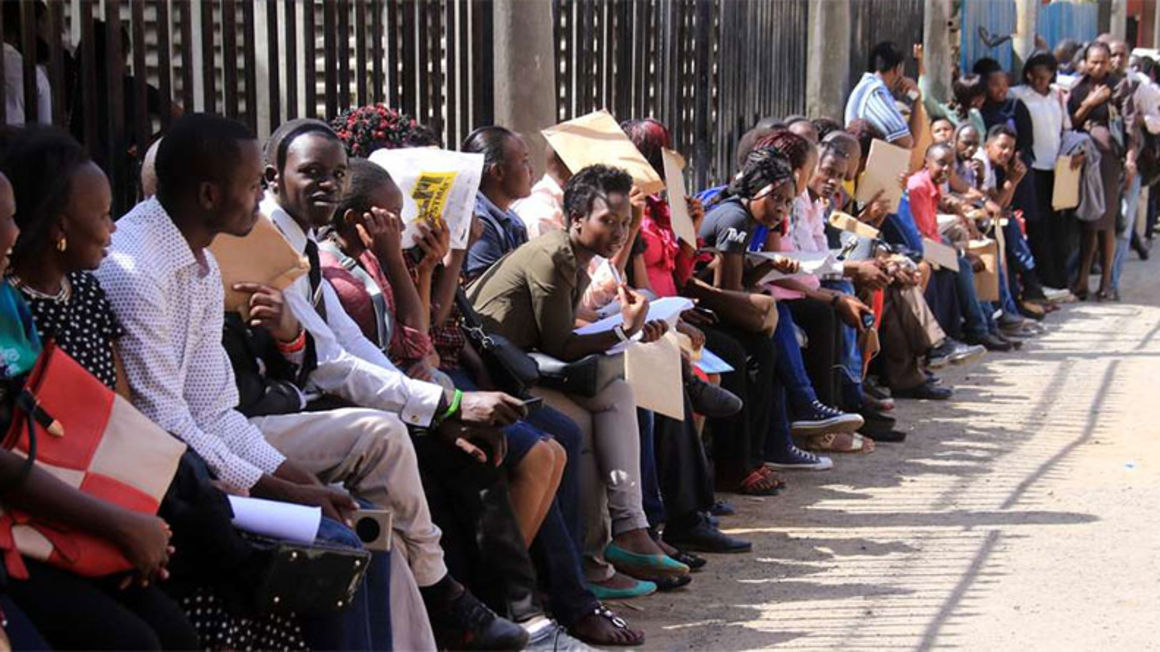
Jobseekers in Nairobi. Kenya has the highest unemployment rate in the region. FILE PHOTO | NMG
Summary
- The Kenya National Bureau of Statistics (KNBS) showed Tuesday that the number of people in employment had increased to 17.67 million in September, up from 15.87 million in the quarter to March.
- This suggests that layoffs have eased and some firms are back to hiring and recalling workers placed on leave despite a rise in coronavirus infections.
- Kenya, which has 94,768 confirmed cases of the Covid-19, up from 38,713 on October 2 and 1,647 fatalities so far, started the gradual re-opening its economy in July.
More than 1.8 million jobs were created in the three months to September, buoyed by more firms resuming operations after the easing of some restrictions imposed to stem the spread of Covid-19.
The Kenya National Bureau of Statistics (KNBS) showed Tuesday that the number of people in employment had increased to 17.67 million in September, up from 15.87 million in the quarter to March when Kenya imposed restriction to curb the spread of the virus.
This suggests that layoffs have eased and some firms are back to hiring and recalling workers placed on leave despite a rise in coronavirus infections.
Kenya, which has 94,768 confirmed cases of the Covid-19, up from 38,713 on October 2 and 1,647 fatalities so far, started the gradual re-opening its economy in July.
The number of people in employment has surpassed those in end March, just days after the pandemic shut down much of business activity throughout the country.
The increased corporate activity has been buoyed by more firms resuming operations and others increasing factory floor activity after the easing of some restrictions imposed to stem the spread of Covid-19.
About 1.72 million workers lost jobs in the three months to June when Kenya imposed coronavirus-induced lockdowns that led to layoffs and pay cuts as firms battled falling sales and losses.
The resumption in hiring is a major boost to jobseekers, especially the close to one million young people who graduate from various educational institutions every year.
“Rising output and order book volumes led companies to raise their staffing levels at the start of the fourth quarter, ending a seven-month sequence of job cuts. The rate of job creation was the strongest in 11 months,” analysts at Stanbic Bank and UK’s Markit wrote in the PMI report.
Activity in the private sector has gathered momentum since Kenya started gradual re-opening of the economy, a turnaround from a steady contraction in the first six months of the year.
Companies were already struggling with flagging sales even before the Covid-induced travel and trade curbs were imposed in late March, exacerbating job losses from April.
Nearly 600,000 jobs were lost between December and March, a pointer that Kenya’s economy was struggling before the local coronavirus outbreak.
Kenya’s economy contracted for the first time in almost 12 years in the second quarter as the impact of the coronavirus pandemic battered key sectors.
Gross domestic product fell 5.7 percent, compared with a growth of 4.9 percent in the three months through March and expansion of 5.3 percent in the similar period a year earlier.
Kenya confirmed its first Covid-19 infection in mid-March and later imposed a partial shutdown.
Key foreign-income earners including tourism and exports, such as tea, flowers, fruits and vegetables bore the brunt of these measures due to lockdowns in key markets and global travel restrictions.
Industries and other businesses cut down on their activities in response to the infectious disease.
“Business confidence has been on the rise over the last couple of months, courtesy of easing domestic containment measures which has boosted demand, albeit from a low base from April/May,” Stanbic Bank head of Africa research Jibran Qureishi said earlier.
Young people were the biggest beneficiary of the employment market recovery compared to their counterparts aged above 35 years, accounting for slight more than half of the reinstated jobs.
About 15,547 workers of aged between 55 and 59 years lost jobs in the three months through September when firms hired 29,196 persons aged 50 and 54 and 14,073 workers above the retirement age of 60.
The Treasury has lowered this year’s economic growth projection because the first half turned out worse than expected, but growth is expected to rebound in 2021.
The economy is expected to grow 0.6 percent this year, Treasury Secretary Ukur Yatani said on November 24, lowering the previous forecast of more than two percent.
Growth is expected to rebound to 6.4 percent in 2021,
said Mr Yatani. “Economic activity has started to show recovery,” the
CS told a meeting to begin preparations for the government’s budget for
the next financial year.





No comments :
Post a Comment